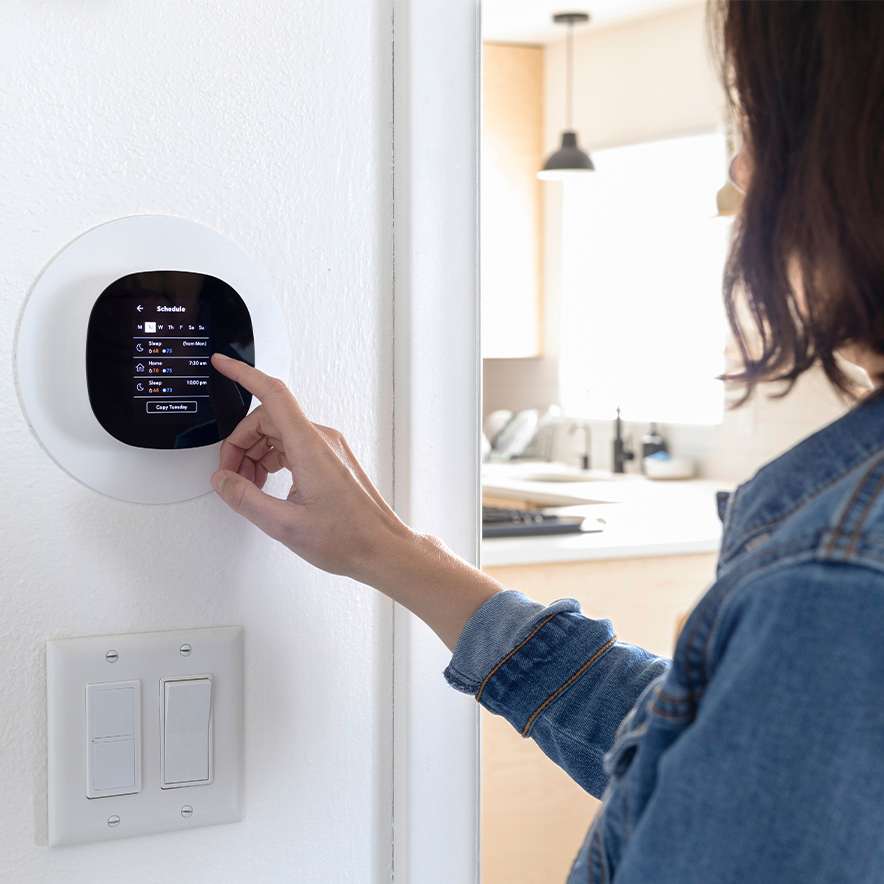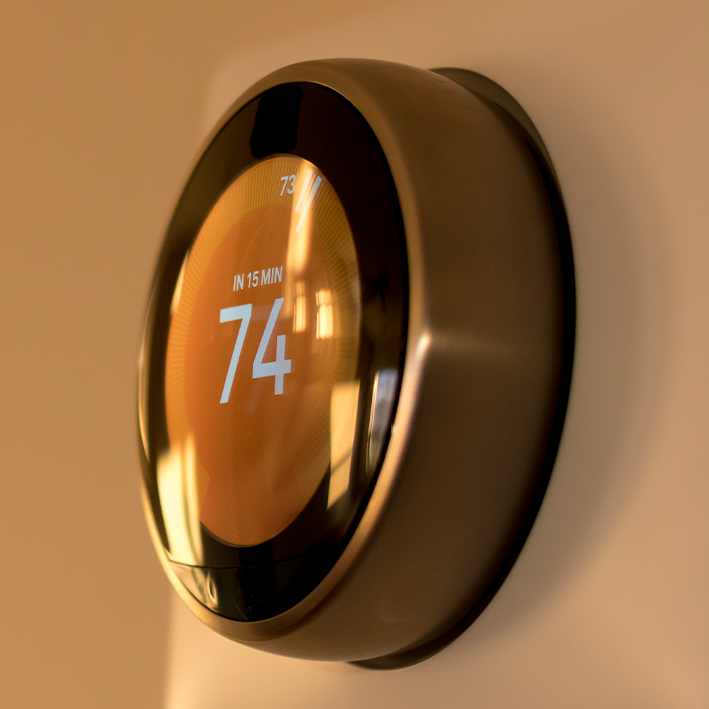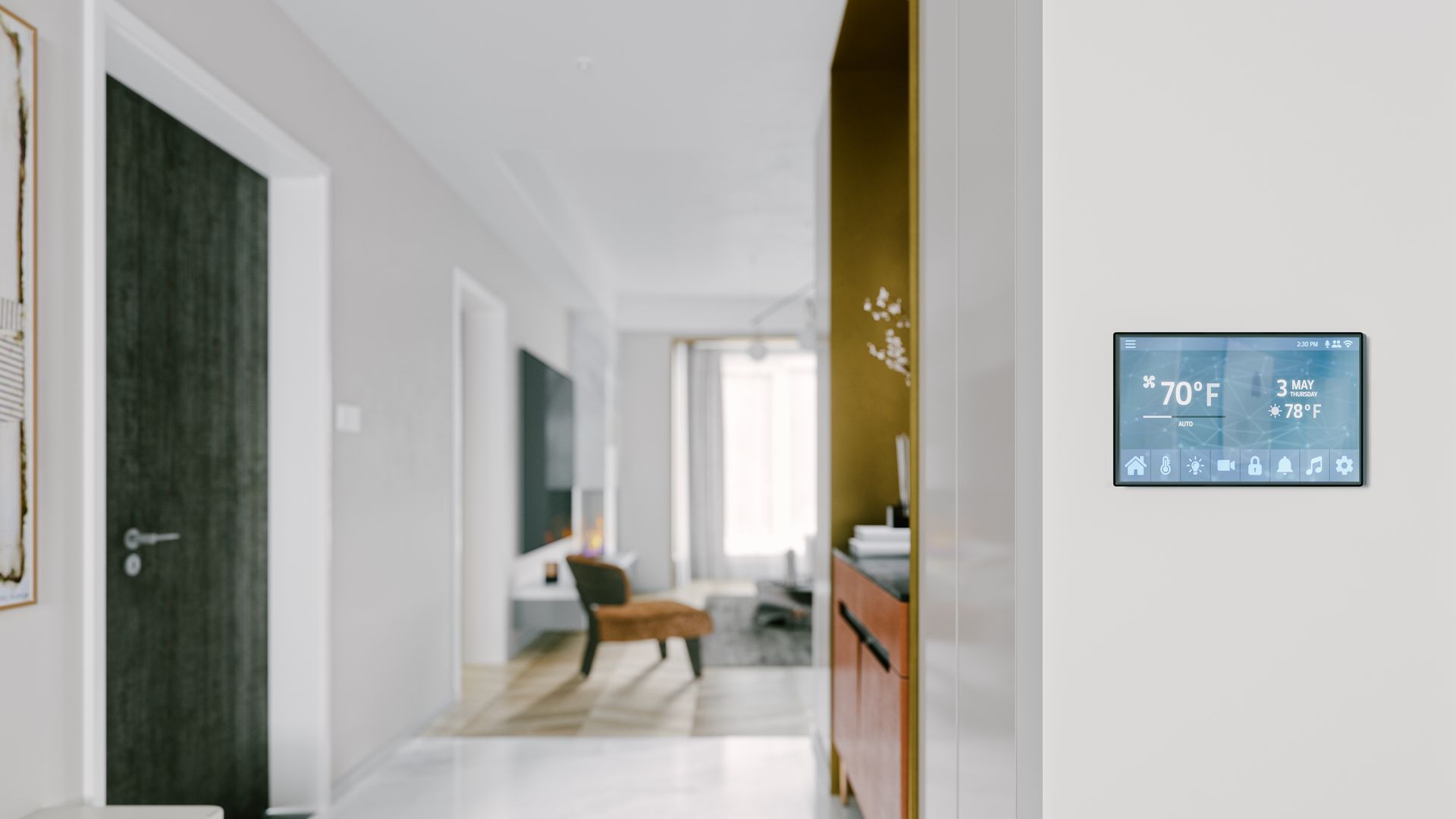Branford Thermostat Services
Thermostat Experts Serving New Haven County, New London County, Middlesex County & Surrounding Areas
Are you tired of fiddling with your aging thermostat? A modern digital, automatic, and fully programmable thermostat can make managing your indoor home comfort easier than ever. It can also provide more reliable performance and significant energy savings over time.
At Air Inc. Heating & Air Conditioning, we can help you explore the latest models and find a solution that suits your specific needs and preferences. Our licensed and insured HVAC technicians can complete a seamless installation that integrates your new thermostat with your heating and cooling systems. We can also walk you through how to make the most of your new thermostat. With over 30 years of experience serving our community and an A+ rating with the Better Business Bureau (including zero complaints since 2000), you can expect honest communication, quality workmanship, and peace of mind.
When you need reliable thermostat services in Branford, call (203) 871-0801 or contact us online to request a free inspection and estimate. Ask about our financing options, warranties, and satisfaction guarantee.
Signs Your Thermostat Needs Professional Attention
Just like any component of your HVAC system, your thermostat will eventually experience wear and tear or even operational glitches. When this happens, it may stop accurately communicating with your furnace or air conditioner, leading to discomfort and wasted energy.
If you notice strange behavior, do not ignore it. We can quickly diagnose the issue and perform the necessary repairs or recommend an upgrade if your thermostat is nearing the end of its expected service life.
Reach out to our technicians to schedule a free inspection if you notice any of the following problems with your thermostat:
- Inconsistent temperature readings. If your home feels much warmer or colder than the temperature displayed on the thermostat, the internal sensor has probably failed or requires recalibration.
- HVAC system constantly cycles. Your thermostat should never turn your furnace or air conditioner on and off in rapid succession. This frequent starting and stopping, known as short cycling, strains your equipment and wastes energy.
- Total loss of power or blank screen. If your digital thermostat screen suddenly goes blank or fails to respond, it might indicate a wiring issue, a tripped breaker, or simply dead batteries. If new batteries or resetting the breaker do not fix it, we need to inspect the wiring.
- Programs fail to hold. If you program a set schedule but your thermostat reverts to a default setting or ignores the schedule altogether, you may be dealing with an internal electronic failure.
- System does not respond to changes. There is likely a communication breakdown between your thermostat and your HVAC equipment if your heating or cooling systems fail to react when you manually adjust the temperature.
- Visible damage. Older mechanical thermostats with visible rust, cracks, or discoloration are likely past their prime and should be replaced.

-
"Well worth it. Will call again next year!"
Susan T.
-
Customer-First ServiceWe believe in honest communication, fair pricing, and lasting relationships. Every service call is backed by our commitment to your comfort, convenience, and peace of mind.
-
Expert Technicians You Can Count OnOur skilled and certified technicians bring years of hands-on experience to every repair, installation, and maintenance job, ensuring your system runs efficiently and reliably year-round.
-
24/7 Emergency ResponseDay or night, our dedicated team is ready to respond to any HVAC emergency. We’re always available to protect your comfort and prevent costly damage when unexpected issues arise.
-
Proven Trust and ReliabilityWith over three decades of experience and an A+ rating from the Better Business Bureau since 2000, we’ve earned a spotless record of customer satisfaction — zero complaints and countless positive reviews that speak for themselves.
How Can a Programmable Thermostat Save Me Money?
A traditional mechanical thermostat uses a simple bimetallic strip or a mercury switch to sense the room temperature and switch your HVAC system on or off. However, it only maintains one setting until you manually change it.
A programmable thermostat, by contrast, uses electronic sensors to measure temperature with greater accuracy and contains a microprocessor that allows you to schedule multiple temperature settings throughout the day and week. You input your desired settings, and the thermostat executes them automatically. For example, during the winter, you may program warmer temperatures for when you usually wake up, cooler temperatures while you are away at work, and back to comfortable temperatures when you return home.


How Long Does It Take to Install a Programmable Thermostat?
For a standard swap, where your home’s wiring is already compatible with the new programmable thermostat, we can typically complete the entire job in about one hour. The replacement process may take a bit longer if the installation requires additional wiring or modifications to your HVAC system.
This timeline includes safely powering down your system, neatly disconnecting and removing the old thermostat, mounting the new digital base plate, wiring the new unit, and securing the faceplate. Our team at Air Inc. Heating & Air Conditioning can handle everything efficiently so you can get back to your day with minimal interruption.
After we physically install the new unit, we can power the system back up and rigorously test both the heating and cooling cycles to confirm flawless operation. Then, we can walk you through the initial programming, set up your desired daily schedule, and show you how to adjust and utilize all the new features.

-
Yes it is. Mitsubishi, Daikin, Carrier and all other manufactures are phasing out the manufacturing of Ductless Air Conditioning ONLY stems. They are being replaced by high efficiency Ductless Heat Pumps, which provide both air conditioning and heating.
It doesn't make economic sense for the manufactures to rearrange an assembly line to make cooling only units, when there is very little cost difference from the manufacturing process of a heat pump.
Find out more about Ductless Heat Pumps here
-
If you know a friend, family member, neighbor, or coworker who’s been having heating or cooling issues, send them our way, and we’ll take great care of them. Refer someone who may need to repair or replace their furnace, boiler, air conditioner, heat pump, water heater, or any other HVAC service.
Your Reward: When your referral purchases a system from Air, Inc., you’ll receive $250. Some of our customers have earned $500–$1,000 just for sending people they know. There is no limit to the number of rewards you can earn. -
Ductless mini-split systems are a premium home comfort solution, not a quick window-unit install. A professionally installed single-zone system typically starts around $6,500–$8,500, depending on the home and installation needs. Multi-zone systems serving several rooms can vary more. Each system requires a licensed, experienced crew to ensure efficiency, safety, and long-term reliability. We provide professional in-home evaluations so you know exactly what’s right for your home and budget.
-
With a multi-zone ductless heat pump, you can connect multiple indoor air handlers—often up to eight—to heat and cool different rooms independently.
-
A ductless heat pump works by moving heat, not creating it. In the summer, it pulls heat out of your home to keep you cool. In the winter, it extracts heat from the outdoor air—even when it’s cold—and brings it inside. Each indoor unit controls the temperature of its own room, providing efficient, quiet comfort without ductwork.
Heating, ventilation, and air conditioning (HVAC) systems are essential for maintaining a comfortable, healthy, and energy-efficient home. A properly functioning HVAC system not only keeps indoor temperatures steady year-round—it also improves air quality by filtering out dust, allergens, and pollutants. Regular maintenance ensures your system runs efficiently, lowering energy bills and extending its lifespan. Whether it’s keeping your family cool in the summer or warm in the winter, your HVAC system plays a vital role in creating a safe and comfortable living environment.



